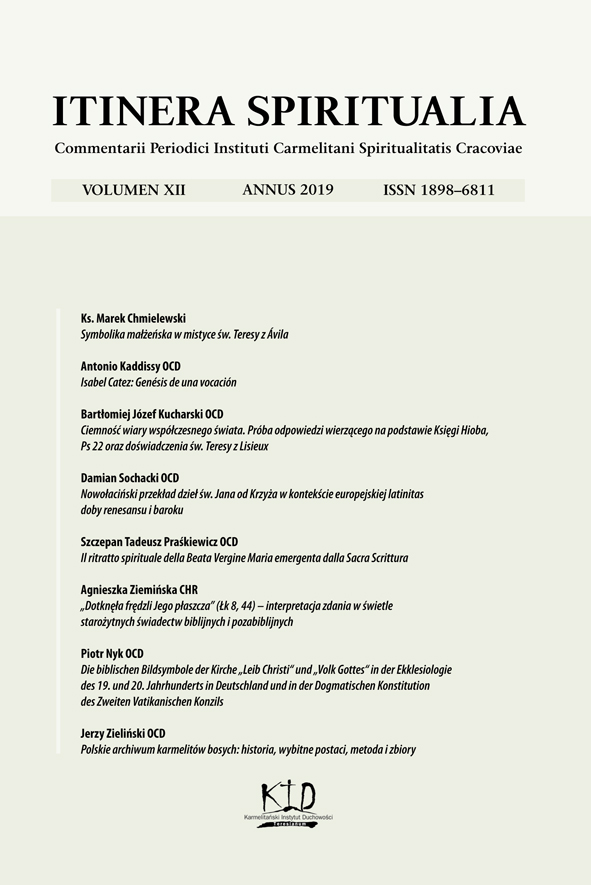"She Touched the Fringe of His Garment" (Luke 8:44). The Interpretation of the Clause in the Light of the Ancient Biblical and Non-biblical Witnesses
DOI:
https://doi.org/10.12775/IS.2019.006Keywords
jewish fringes, tzitzit, denotation of attire, women with a discharge of bood, Haemorrhoissa, ritual impurity, touching the fringe of a cloakAbstract
Touching Jesus’ garment by a woman suff ering from a twelve-year discharge of blood rendered an uncontrolled fl ow of power (δύναμις) from his body and cured her. Did the fact that the woman’s touch concerned this specifi c part of the robe of the Master of Nazareth have some meaning? Bearing in mind the law of wearing tassels upon the hem of the garment (Deut 22:12) as well as the prophecy from Zach 8:23, we follow the history and the meaning of this appendage to the garment. It is certain that tassels upon robes were not an idea that originated in Jewish culture. We find evidence of garments with this kind of adornment on two Minoan seal stones from around the 17th c. BC, Assyrian bas-reliefs (9th c. BC) and also on some Egyptian artefacts (starting from around 15th c. BC). They are visible as additions to the robes of both important people (king, priest) and deities. In many cultures, tassels upon the robe gave a special status to the person who wore them. They served as seals and as such they constituted an alter ego of a person. Touching or grasping the fringes of someone’s robe gave the owner an aff ection and gave him that person’s power. It seems that the Jews, to the pre-existing custom of wearing this ornament, added, following God’s command, a specifi cally Jewish order to put in the tassels a blue thread (Num 15:38). Wearing the fringes widened with a new dimension – they were supposed to remind people of God’s commandments and his presence. In the case of the sick woman touching Jesus and also in the passage of Matt 14:34–36, where the sick people ask whether they could touch “the fringes of his cloak” both dimensions (ethnic – power, and specifi cally Jewish – memory of God commandments) are significant.References
BAERT B., Touching the Hem: The Thread between Garment and Blood in the Story of the Woman with the Haemorrhage (Mark 5:24b–34parr), „Textile: The Journal of Cloth and Culture” 9 (2011), s. 308–351.
BATTEN A.J., Clothing and adornment, „Biblical Theology Bulletin” 40/3 (2010), s. 148–159.
BERTMAN S., Tasseled Garments in the Ancient East Mediterranean, „The Biblical Archaeologist” 24/4 (1961), s. 119–128.
BOKSER B.Z., The Thread of Blue, „Proceedings of the American Academy for Jewish Research” 31 (1963), s. 1–32.
GLOVER A.K., Modern Jewish Customs as Possible Helps in Bible Study, „The Biblical World” 18/1 (1901), s. 7–12.
GLOVER A.K., The Dress of the Master, „The Biblical World” 15/5 (1900), s. 347–357.
GOODNICK B., The Tassel and the Blue Cord, „Jewish Bible Quarterly” 21/2 (1993), s. 99–108.
KUBIŚ A., Kobieta cierpiąca na krwotok oraz córka Jaira jako symbol Izraela. Próba analizy symbolicznej Mk 5, 21–43, w: Studia nad Ewangelią według św. Marka.
Nowy Testament: geneza – interpretacja – aktualizacja (Lingua Sacra. Monografie 8), red. W. Linke, J. Kręcidło, Warszawa–Ząbki 2017, s. 66–111.
MILGROM J., Of Hems and Tassels, „Biblical Archaeology Review” 9/3 (1983), s. 61–65.
MILLER S., Women in Mark’s Gospel, London–New York 2004.
STEPHENS F.J., The Ancient Signifi cance of Ṣîṣîth, „Journal of Biblical Literature” 50/2 (1931), s. 59–70.
STRZAŁKOWSKA B., Rozporządzenia dotyczące kobiet w Kpł 15 (Rozprawy i studia biblijne 20), Warszawa 2006.
Tora Pardes Lauder. Bemidbar, red. i tłum. S. Pecaric, Kraków 2005.
VRIES S.P.D. DE, Obrzędy i symbole Żydów, tłum. A. Borowski, Kraków 2001.
Downloads
Published
How to Cite
Issue
Section
License
1. Under the Polish legislation, the author transfers to the journal publisher the exploitation rights concerning the published material in the paper version of the journal.
2. With the journal consent, the publication can be later republished by the author elsewhere.
3. The journal publishes the submitted material online on the basis of CC license Attribution-NoDerivatives 4.0 International.
Stats
Number of views and downloads: 5861
Number of citations: 0



